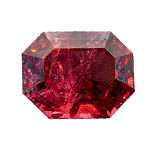Eudialyte
A rare mineral belonging to the class of silicates and germanates.
Facet grade eudialyt is extremely rare. We know of only two small localities that existed in Quebec Province, Canada, namely Mont Sainte-Hilaire and Lake Kipawa (Sheffield Lake). Both deposits seem to be exhausted.
The Mont Sainte-Hilaire stones were mostly tiny, quite dark and in general of rather poor quality.
From the 1990ies into the early years of the current century Lake Kipawa produced somewhat larger and significantly better material.

Eudialyte fromLake Kipawa
Origin of name: from Greek εὖ [eû] good and διάλυτος [dialytos] decomposed, because of it´s ready solubility in acid
Synonyms and trade names: an opaque variety from Kola Peninsula, Russia, is sometimes called Sámi Blood. According to a legend the blood shed by a Sámi warrior during a fight turned into stone - the rd eudialyte spots in the otherwise dark mother rock of the Kola Peninsula.
Can be confused with: many other red gemstones
Localities: on all continents including Antarctica. Only the two Canadian as well as the Russian deposit are of gemmological interest. The Russian material is opaque, black with red spots and mainly used for cabochons and tumbled stones.
Handling: : due to the relatively low hardness, the good to perfect cleavage and its solubility in acids eudialyte´s use as a gem is limited. Cabs cut from Russian material can be quite pretty but must be worn with care.
Worth knowing: Eudialyte often contains traces of Thorium and Cerium as well as, somewhat rarer, Uranium, Hafnium, Niobium and Lead and thus is very mildly radioactive. But don´t worry! The radiation is neglectable. If you hold 1g of pure eudialyte (that´s a sphere of 8.7mm) in your hand continuously for one year, the exposure would amount to approximately 175 microsievert. According to the WHO the critical value for an adult is 500.000 microsievert per year.
 Deutsch
Deutsch